Site menu:

March 2013 Newsletter
Highlights - March 2012 to Feb 2013.
Highlights last five years.
Appeal for Voluntary Wardens at Neston Reedbed.
February Bird News.
Forthcoming Events.
Latest Newsletter.
Highlights - March 2012 to February 2013
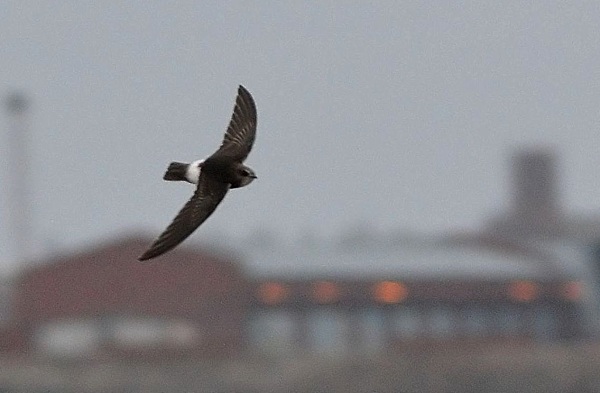
The Website is 15 years old this month and as usual I do the highlights from the previous 12 months.
Rarities
Some good rarities, here is a
summary of some of the more
interesting ones:
Six White Storks seen in a field by
Holywell on Apr 22nd were somewhat
unexpected, they were also observed and photographed by none other than
birding icon Alan Davies the following day flying over his house by
Llandudno so there is no doubt that this was a genuine record.
May was a good month at Burton Mere
Wetlands with both a Black-winged
Pratincole and a Temminck's Stint, the latter was also seen on the
Donkey Stand Flash at Parkgate.
A Golden Oriole was briefly at
Leasowe Lighthouse
on May 18th and there was a probable the following
month around Burton
and also at a mysterious location not disclosed by
the
observer even though it wasn't on private land!
In contrast we had no problems seeing a Little Swift at New Brighton
present for several days at the end of June, often observed flying over
the
River Mersey. August brought in an Aquatic Warbler at Red Rocks and a
Balearic Shearwater off Hilbre.
A good number of waders at Hoylake
in September included a rare
American wader - but was it a Semipalmater Sandpiper or the even rarer
Western Sandpiper??? Even with several decent photographs of this bird
it is proving very difficult to ID for sure and BBRC are still to give
their verdict. I understand that they might even just call it
'Semipalmated/Western Sandpiper'!
Spring Migration
With the first Sand Martin recorded on Feb 28th (2012) spring started early. After that things were generally a bit slow but marked by days of some huge falls and large numbers of birds on passage.
First up was a conservative estimate of at least 200 Goldcrests on Hilbre on March 15th, 80 of which were trapped for ringing. It was regarded by members of the Hilbre Bird Observatory as the best March migration day they could remember.
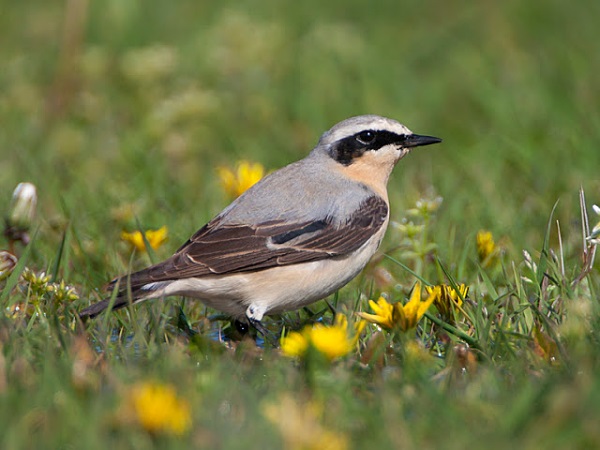
see www.fromthemuddybanksofthedee.com blog.
We had to wait until the end of April for some mild southerly winds, but it was worth the wait with Leasowe Lighthouse and Hilbre being the focus of attention. The flooded and wild flower packed horse paddocks to the west of Leasowe Lighthouse were full of birds for three days including over 100 Wheatear, five Redstarts and ten Whinchats on May 2nd. On the same day Hilbre saw probably the largest ever fall recorded there with over 200 Wheatear, 800 Willow Warblers, 3,000 Swallows and six Redstarts!
May 26th saw a massive passage of
Swifts and hirundines at Hilbre
and Red Rocks
with 3,200 Swifts, 500
Swallows and 200 House Martins the max counts.
Summer and Autumn
It was good to see many Common Terns
with around 1,000 being recorded
on several dates from June to August. These are the biggest numbers
since the demise of the Shotton colony a few years ago, many of these
terns have moved to the colony at Seaforth and birds could be seen
flying to
and from that direction throughout the breeding season. Similar numbers
of Sandwich Terns were also
recorded but more unexpected were up to 200 Arctic Terns. Particularly
nice to see were up to 11 Black Terns present for several days in
August off Hilbre
and Red Rocks.
Also in August were six Marsh
Harriers on the marshes and
Burton Mere Wetlands
including two juveniles tagged in East Anglia.
The new reserve attracted good numbers of Avocets and 35 chicks were
succesfully fledged. There was another massive fall of Willow Warblers
on Hilbre
with 700 on
Aug 14th. September brought in the usual gales, the wind was in the
wrong direction for large numbers of Leach's Petrels but we did have 95
coming past Hilbre
on the 19th. There were also good numbers of Skuas
including 68 Arctic off Hoylake.
Visible Migration in October was good
without being spectacular -
except for an amazing 47,000 Starlings counted over Red Rocks, many in
one huge flock!!
Winter
Large numbers of Knot were present all
winter with counts not seen here
since the 1970s. Over 50,000 were counted during a WeBS count in
December and 48,000 were feeding off Thurstaston
in January. 1,900
Sanderling at Hoylake
in November was also an exceptional count.
It was fantastic to see three 'grey'
male Hen Harriers on the marshes,
we are not sure exactly how many ringtails there were but probably at
least three.
Pink-footed Geese over-wintering off
Parkgate and Burton reached over
3,000, a number not dreamt of a few years ago! Unfortunately, unlike
last winter, they mostly stayed right out on the far edge of the marsh.
Last, but certainly not least, were the
Waxwings. It is remarkable that
we've had three very large invasions of this species in just eight
years - when normally just one every 10 to 20 years would
be expected.
I'll be writing an article about these after the winter.
Top
of Page
My Highlights of the Last Five Years
This Website has never been just about Richard Smith's sightings, but rather the sightings and observations of all the birders who birdwatch on the Dee Estuary. However, on the 15th anniversary of the start of the website I hope you will indulge me if I reminisce about some of my own favourite moments of the past five years. It's been very difficult to choose but, so as not to make the article too long, I've written about just five highlights rather than the 16 originally chosen!
High Tide at Parkgate
I'm sure it is true to say that more birders come to Parkgate for a 'big tide' than any other place or event on the Dee Estuary. Unfortunately the winds are not always kind and sometimes the sea doesn't cover the marsh, but when it does it is truly spectacular. I have been lucky enough to see many big tides but two dates from the past five years stand out.
The first is March 10th 2008 and it was
a really big one with the sea
racing into the wall at the Old Baths a good 45 minutes before high
water. It was one of those days when Water Rails were everywhere with
birds swimming on the sea, hiding under the sea wall and flying over
our heads inland. The total for the day was reckoned to be 21 and is by
far the biggest count of Water Rails for the past five years. It was
also a good day for rodents with plenty seen desperately trying to
escape the sea and the gulls, we also often see a fox or two and on
that particular day I rescued a mole from drowning!
The second date was February 2nd 2010. Again the tide came right in but
I had walked down towards Gayton which is the best place to see
Short-eared Owls, and I was rewarded with a fantastic total of 12. We
can, occasionally, get larger numbers at Burton, but the magic
of Parkgate
is that the owls are so close and we can easily see them on
the ground (before the tide covers it) as well as in the air, giving
some fabulous views of these graceful birds. Then there were
also
Hen Harriers, Merlins, Peregrines, Jack Snipes, numerous duck and
geese, waders by the thousand..........
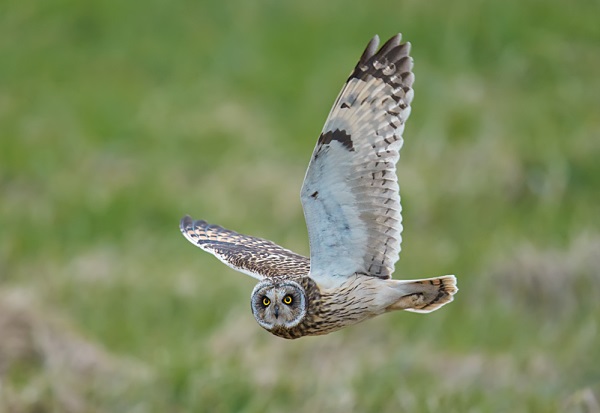
Leach's Petrels
It wasn't until I started this website that I realised that North Wirral, Hilbre and Point of Ayr are the best places to see Leach's Petrel in the whole country. We don't see them every year, and some years we only get a handful, but occasionally we get hundreds coming through - such a year was 2010.Large numbers were recorded on four days, September 14th to 17th. Having had a good few hours at New Brighton on the 15th I decided to go to Hilbre the following day. None of the Hilbre Bird Observatory members were on the island when I arrived about mid-morning, but three local bird watchers who I knew very well were there, one of them had arrived at 6.30am and had been systematically counting everything going past the island, including a steady stream of Leach's Petrels. All three of these birders had to leave around mid-day leaving me alone on the island with the responsibilty of taking over the count. What a privilege! I had often read of marathon sessions on Hilbre in the teeth of gales and here was I doing one myself. Despite the strong wind I was nice and sheltered in the lee of the old life-boat station and I watched those wonderful birds flying by for three and a half hours. Hours which I'll remember for the rest of my life!
Black-tailed Godwits
It was early December 2010 and just at the start of the coldest spell many of us can remember, but lovely and sunny with no wind. I was down at my usual haunt at Thurstaston when the godwits started to fly in from their roost at Heswall as the tide went out. They were obviously very hungry after the cold night and immediately started feeding in the thick mud, with numbers soon reaching well over 1,000. They are much more sociable than the bigger Curlew and always feed in a fairly tight flock usually all steadily walking in the same direction. That day they all started walking towards me on the beach and I couldn't believe how close they were coming, just a few feet away. Suddenly they all started 'talking', calling to each other with a soft twitter - an amazing sound when they are so close. Soon three of my birding friends joined me, they had the same objective as myself - to search through the godwits for colour rings. As I recall we got 13 ringed birds that day, which is a good total, and when we got the feedback we found out about their history and travels around Iceland and western Europe. I've had many great days like that at Thurstaston over the years but that one stands out as a particularly special one.
Yellow Wagtails
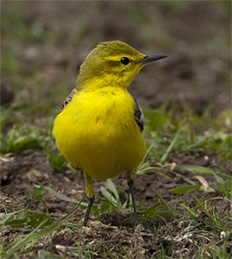 These are really striking
looking birds
- the males are literally
bright yellow and wouldn't look out of place in the Amazon rain forest
with the females equally beautiful, but more of a paler primrose
yellow. We usually get a few males passing through on spring migration
with the best site being the horse paddocks at Leasowe Lighthouse.
Until May 5th 2011 I'd seen very few of these birds, just the
occasional group of two or three, all males, which is a fairly
typical. But on that date a large flock turned up, I
saw 30 and the maximum count that day was 58 including many
females. As
well as the spectacle of seeing so many of these beautiful birds what
struck me was the way they were behaving. Usually the small groups just
steadily feed, perhaps occasionally flying a small distance from one
area to another. In contrast, the birds in this large flock were very
restless, continually flying up and reminding me of leaves being blown
by gusts of wind, they were also continually moving between the
different fields and the sea defence so we kept thinking they had gone
when suddenly they would all come back again. That was the biggest
flock recorded at Leasowe for at least 20 years, a wonderful sight!
Photo by Matt Thomas.
These are really striking
looking birds
- the males are literally
bright yellow and wouldn't look out of place in the Amazon rain forest
with the females equally beautiful, but more of a paler primrose
yellow. We usually get a few males passing through on spring migration
with the best site being the horse paddocks at Leasowe Lighthouse.
Until May 5th 2011 I'd seen very few of these birds, just the
occasional group of two or three, all males, which is a fairly
typical. But on that date a large flock turned up, I
saw 30 and the maximum count that day was 58 including many
females. As
well as the spectacle of seeing so many of these beautiful birds what
struck me was the way they were behaving. Usually the small groups just
steadily feed, perhaps occasionally flying a small distance from one
area to another. In contrast, the birds in this large flock were very
restless, continually flying up and reminding me of leaves being blown
by gusts of wind, they were also continually moving between the
different fields and the sea defence so we kept thinking they had gone
when suddenly they would all come back again. That was the biggest
flock recorded at Leasowe for at least 20 years, a wonderful sight!
Photo by Matt Thomas.
Knot
The winter of 2012/13 was remarkable for the large number of Knots present. I love counting large flocks of waders and spent many days at both Thurstaston, where they feed at low tide, and at Hoylake where many roost at high tide. I had some very high counts including 37,000 at Hoylake and 48,000 at Thurstaston, but three particular occasions stand out.
The first was a lovely still sunny November morning at Thurstaston. As I walked along the beach I could see 20,000 Knot on the far side of the channel about 200 yards away. Suddenly the whole flock took off all together - the roar of wings was just incredible. I've heard flocks take off before but not so many birds, so close and in completely still conditions. Fantastic!
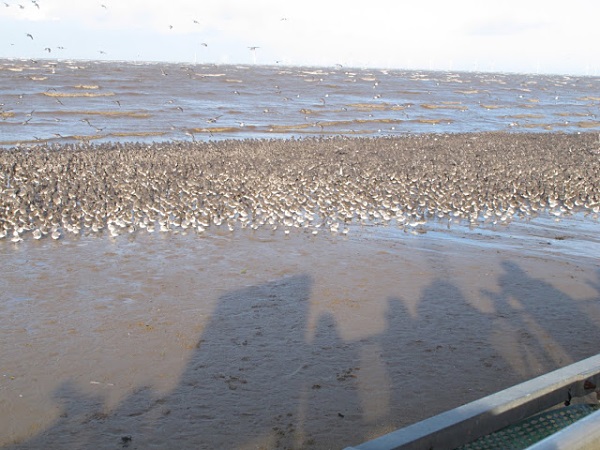
see www.fromthemuddybanksofthedee.com blog.
The other two days were during the January spring tides at Hoylake, and an astonishing two days they were. On both days we had about 30,000 waders present, an amazing sight in itself, the majority being Knot. On the Sunday (13th) there were one or two raptors around and this meant that the birds were restless and about half the birds aerial roosted. I've seen many wader roosts over the years and am used to birds being 'flighty', but this was something different. There was continous movement with thousands of birds landing and taking off at any given time, and when they were in the air the Knots were right over our heads seemingly flying quite slowly and forming V-formations, presumably to save energy. It was the first proper aerial roost I've ever seen.
The next day was even more spectacular. The tide was higher so that there was just a thin strip of sand left for the birds to roost on. Unlike the previous day the birds stuck to the beach like glue, hardly flying at all. So we were looking at this huge number of birds from just a few feet away. Although they were not flying there was still constant movement with the birds surging backwards and forwards, sometimes as waves came in, at other times for no apparent reason - but they didn't seem bothered at all by we birdwatchers. As a wildlife spectacle it must rank as one of the best in the world, let alone in the UK! We were lucky as normally on spring tides, i.e. when little beach is left to roost on, all the birds will leave well before high tide and fly to either Point of Ayr or Formby/Alt Estuary where there is more space to roost - leaving nothing to see at Hoylake. Those two days were certainly the best two days at Hoylake I've ever had!
Richard Smith
Voluntary Wardens Needed to Protect Neston Reed Bed
 Once
again the RSPB are organising voluntary wardening at Neston Reed Bed,
the scheme will begin near the end of March and run through until the
end of May. Wardening will take place each evening in order to protect
this important habitat from disturbance. I know in the past this scheme
has attracted birders who have realised what a good opportunity this
location is for some serious birdwatching with the possibility of
seeing migrating Ospreys and Marsh Harriers, large numbers of Little
Egrets flying in to roost, Bearded Tits, Hen Harriers, Short-eared Owls
and the numerous birds which breed in the reed bed. If you are
interested please contact Geoff Robinson (Geoffrey.Robinson@rspb.org.uk),
telephone 0151 353 8478.
Once
again the RSPB are organising voluntary wardening at Neston Reed Bed,
the scheme will begin near the end of March and run through until the
end of May. Wardening will take place each evening in order to protect
this important habitat from disturbance. I know in the past this scheme
has attracted birders who have realised what a good opportunity this
location is for some serious birdwatching with the possibility of
seeing migrating Ospreys and Marsh Harriers, large numbers of Little
Egrets flying in to roost, Bearded Tits, Hen Harriers, Short-eared Owls
and the numerous birds which breed in the reed bed. If you are
interested please contact Geoff Robinson (Geoffrey.Robinson@rspb.org.uk),
telephone 0151 353 8478.
Top
of Page
February Bird News
Those of us who were expecting a repeat of the January wader roost spectacular at Hoylake during the spring tides were in for a huge disappointment with hardly a wader to be seen! But there was some compensation with the presence of a massive number of gulls.
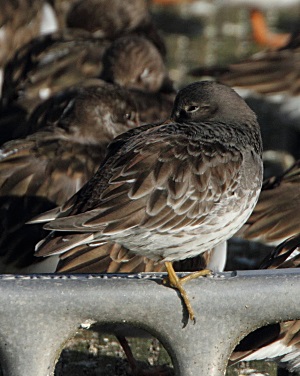 There
must have been well over 20,000 gulls along north Wirral for several
days, during the second week of the month. I had 17,500 Herring Gulls
off Meols on the
7th and there were 8,000 Black-headed Gulls
at Hoylake
on the 9th. Among this throng were spotted two Caspian Gulls
and
three Mediterranean Gulls. This influx
coincided with some strong
south-west winds and on the 9th this brought in a Black-throated Diver,
a Great Northern Diver and 33
Red-throated Divers past Hilbre. By the end of the
month the weather went much colder again with east winds and the waders
returned including 22,000 Knot at Hoylake. Max counts of
Purple
Sandpipers at New
Brighton was 21 with 380 Turnstones there on
the 11th. We've had just the one day of calm weather coinciding with
excellent visibility this year, on Feb 27th and consequently I managed
an excellent count of 804 Great Crested Grebes off north Wirral.
There
must have been well over 20,000 gulls along north Wirral for several
days, during the second week of the month. I had 17,500 Herring Gulls
off Meols on the
7th and there were 8,000 Black-headed Gulls
at Hoylake
on the 9th. Among this throng were spotted two Caspian Gulls
and
three Mediterranean Gulls. This influx
coincided with some strong
south-west winds and on the 9th this brought in a Black-throated Diver,
a Great Northern Diver and 33
Red-throated Divers past Hilbre. By the end of the
month the weather went much colder again with east winds and the waders
returned including 22,000 Knot at Hoylake. Max counts of
Purple
Sandpipers at New
Brighton was 21 with 380 Turnstones there on
the 11th. We've had just the one day of calm weather coinciding with
excellent visibility this year, on Feb 27th and consequently I managed
an excellent count of 804 Great Crested Grebes off north Wirral.Purple Sandpiper photo by Keith Scovell keithscovell.blogspot.co.uk.
A Lesser Scaup at Shotton Pools on the 2nd was a good find. There was also a nice flock of 35 Scaup seen off both Hilbre and Leasowe Lighthouse early in the month. 3,200 Pink-footed Geese were off Parkgate on the 2nd. Other good records were a Spoonbill at Parkgate on the 3rd and a large flock of Twite at Flint all month, max 54 on the 24th. There were also two Great White Egrets usally spotted off either Burton or Parkgate.
Up to four Short-eared Owls and a Barn Owl have been giving people excellent views off the Old Baths car park at Parkgate for most of the month, best seen early morning and late afternoon up to dusk.
Richard Smith.
What to expect in March
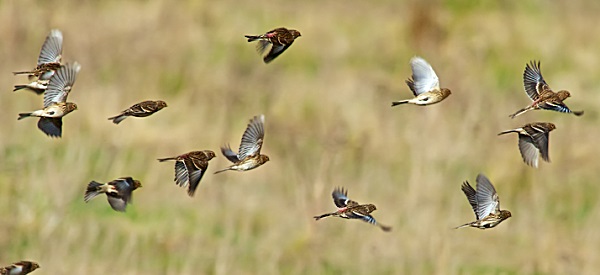
| Species | 2012 | Location (2012) | 2011 | 2010 |
|---|---|---|---|---|
| Sand Martin | 28th Feb | Leasowe Lighthouse | 12th March | 18th March |
| White Wagtail | 8th March | Leasowe Lighthouse | 11th March | 12th March |
| Wheatear | 9th March | Leasowe Lighthouse | 13th March | 10th March |
| Swallow | 17th March | Red Rocks | 20th March | 18th March |
| Willow Warbler | 20th March | West Kirby | 16th March | 19th March |
| Whitethroat | 1st April | Hoylake | 8th April | 7th April |
| House Martin | 4th April | Burton Mere Wetlands | 25th March | 30th March |
| Cuckoo | 14th April | Leasowe Lighthouse | 20th April | 10th May |
| Swift | 26th April | Leasowe, Burton, West Kirby and Hilbre | 17th April | 19th April |
Waders to look out for are Avocets which will be returning to, or passing through, RSPB Burton Mere Wetlands - we look forward to another great breeding season like last year! Black-tailed Godwits will be on their way north with many starting to acquire their striking breeding plumage, look out for these at Burton Mere Wetlands, Warren Farm at Talacre and Gilroy Nature Park in West Kirby - at migration time they seem to prefer fresh water sites as opposed to the estuary. Any large flocks of Knots are likely to be on their way to the Ribble Estuary where they moult prior to their flight to Canada to breed.
Sea-watching will certainly be worthwhile and Little Gulls will be passing through Liverpool Bay heading towards Crosby and Seaforth prior to flying overland on their way to the Baltic. Some years we can get large flocks of Scoters and, given a south-west wind, we should start to see Gannets off-shore. Sandwich Terns are always the first of the terns to arrive back and should be seen this month. Additionally there will be divers, grebes and various sea-ducks out there.
We can still expect flocks of Waxwings, don't forget to report any sightings of these to me so I can include them in my forthcoming article (probably in May).
Top of Page
Forthcoming Events
March Highest Spring Tides (Liverpool)
Also
see Tides
page.
12th March, 11.24hrs (GMT), 9.7m.
13th March, 12.02hrs (GMT), 9.7m.
Forthcoming Events
Organised by the Wirral
Ranger Service , Flintshire Countryside Service and/or the
RSPB:
All these events and walks have bird interest, even those not
advertised specifically for birdwatching. No need to book for these
events unless specified - please check below.
Also see 2013 Events Diary.
11:00 am start - high tide 13.30hrs 9.3m.
You will discover why Wirral’s foreshore is an internationally protected site when you join the Dee Estuary Voluntary Wardens, Coastal Rangers and the RSPB on this winter birdwatch at Hoylake. Dress warmly and bring binoculars if you have them.
No need to book.
Meet at the bottom of Trinity Road, North Parade, Hoylake promenade.
Please ring (0151) 648 4371 if you need more information.
Saturday 2nd March, Guided Walk at Point of Ayr, Flintshire.
11am start.
Price: Free, but Booking essential - please ring 0151 353 8478.
The Point of Ayr is a fantastic mosaic of habitat right on the seaward edge of the RSPB Dee Estuary nature reserve.
Join our team of knowledgable staff and volunteers as we explore the area looking for early migrants before settling into the new hide for the rising tide which, pushes in thousands of wading birds.
Meet in the "Smugglers Inn" car park at the end of Station Rd.
RSPB Point of Ayr, Talacre, Flintshire.
Sunday 3rd March:
Skydancers at Parkgate - 12 noon until dusk.
Skydancer is an exciting new four-year project aimed at raising awareness and promoting the conservation of hen harriers in the north of England.
The Dee Estuary is a vital wintering ground for these amazing birds and is the best place to see them from October through to March.
Most people have never seen a hen harrier, but once seen it is rarely forgotten. This bird is a beautiful, agile hunter, and its aerobatic sky dances are among the most awesome spectacles in nature.
Unfortunately, with only a handful of pairs still breeding successfully in England, the hen harrier is currently a species on the brink.
Come along to Parkgate to find out more about the hen harrier story and what you can do to help save hen harriers before it's too late!
Look for the RSPB Love Nature marquee along the main promenade at Parkgate where friendly staff and volunteers will be with telescopes and binoculars plus family activities, free information and more: http://www.rspb.org.uk/skydancer/
Directions: The "Donkey Stand" opposite Nicholls Ice-cream shop on The Parade (B5135), Parkgate, Cheshire.
Sunday 17th March, 12:30pm - 2:00pm, Spring Nature Walk - Wirral Country Park at Thurstaston.
Join the Ranger for a walk looking for signs of Spring.
Maximum number 20 people.
Please wear suitable footwear.
Meet at the Visitor Centre at Thurstaston.
Telephone: 0151 648 4371 for details.
